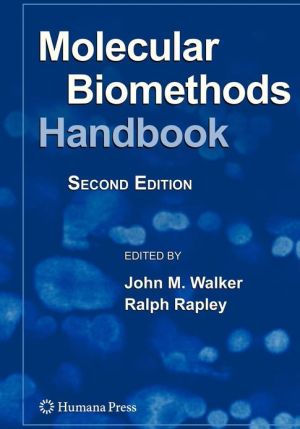

 |

|

Sold Out
Book Categories |
Molecular Biomethods Handbook 2nd Ed
Contents
PART A: NUCLEIC ACID BIOMETHODS
1 The manipulation of nucleic acids: basic tools and techniques – Gayle Corkill and
Ralph Rapley
2 Restriction Enzymes – Gareth J.S. Jenkins
3 Principles and Medical Applications of the Polymerase Chain Reaction – Birmal D.M.
Theophilus
4 Probe Design, Production, and Applications – Marilena Aquino de Muro
5 Southern Blotting as a Diagnostic Method – Bronwen Harvey and Pirkko Soundy
6 Introduction to Capillary Electrophoresis of DNA - Beatriz Sanchez-Vega
7 Denaturing High-Performance Liquid Chromatography (DHPLC) for nucleic acid
analysis - Kim Hung Leung and Shea Ping Yip
8 Denaturing Gradient Gel Electrophoresis (DGGE) – Jeroen H. Roelfsema and Dorien
J.M. Peters
9 Single Strand Conformation Polymorphism (SSCP) Analysis - Kim Hung Leung and
Shea Ping Yip
10 Randomly amplified polymorphic DNA (RAPD); a useful tool for genomic
characterization of different organisms - Lúcia Maria da Cunha Galvão and Eliane
Lages-Silva
11 Quantification of mRNA using Real Time RT-PCR – the SYBR solution - David
Sugden and Patricia de Winter
12 Quantitative Analysis of DNA Sequences by PCR and Solid Phase Sequencing – Anu
Suomalainen and Ann-Christine Syvanen
13 MAPH (Multiplex Amplifiable Probe Hybridization) - Carolina Sismani, Ludmila
Kousoulidou and Philippos C. Patsalis
14 Gene Expression Profiling - Arnis Druka, Robbie Waugh and Pete Hedley
15 Comparative Genomic Hybridization in Clinical and Medical Research – Peng-Hui
Wang, Yann-Jang Chen and Chi-Hung Lin
16 Subtractive Hybridization – Craig Winstanley
17 Fluorescence in situ Hybridization - Jane Bayani and Jeremy A. Squire
18 Quantitative Trait Locus Mapping to Identify Genes for Complex Traits in Mice -
Jonathan D. Smith
19 cDNA Microarrays – Phillip G. Febbo
20 Mapping Techniques – Simon G. Gregory
21 Single Nucleotide Polymorphisms Overview – Nameeta Shah
22 Bioinformatics Tools for Gene and Protein Sequence Analysis– Bernd H.A. Rehm and
Frank Reinecke
PART B: PROTEIN AND CELL METHODS
23. Protein Electrophoresis - David Sheehan and Siobhan O’Sullivan
24. Protein blotting - Patricia Gravel
25. Capillary electrophoresis of proteins - Mark Strege
26. Autoradiography and fluorography - Bronwen Harvey
27. Mass spectrometry of proteins & peptides - Kenneth G. Standing
28. Post-translational modifications - Christoph Kannicht and Birte Fuchs
29. Protein microarray technology - Charlotte H. Clarke and Eric T. Fung
30. Protein-protein interactions - Hae Ryoun Park, Lisa Montoya Cockrell, Yuhong Du, Andrea Kasinski, Jonathan Havel, Jing Zhao, Francisca Reyes-Turcu, Keith Wilkinson and Haian Fu
31. Glycoprotein analysis - Terry Butters and David C.A. Neville
32. Solid Phase Peptide Synthesis - Mare Cudic and Gregg B. Fields
33. Monoclonal antibodies - Zhong J. Zhang and Maher Albitar
34. Antibody Phage display - Rob Aitken
35. Protein engineering - Thomas Willemsen, Urs B. Hagemann,
Eva M. Jouaux, Sabine Stebel, Jody M. Mason, Kristian M. Müller and Katja M. Arndt
36. Directed protein evolution - Sabine C. Stebel, Annette Gaida, Katja M. Arndt and Kristian M. Müller
37. Enzyme Linked Immunosorbent Assay - John Crowther
38. Epitope mapping - Glenn E. Morris
39. Quantum dots - Charles Hotz
40. Ion exchange chromatography - David Sheehan
41. Size exclusion chromatography - Paul Cutler
42. Hydrophobic interaction chromatography - Paul A. O’Farrell
43. Affinity chromatography - Adam Charlton and Michael Zachariou
44. High Performance Liquid Chromatography
(HPLC) of Proteins and Peptides - Tzong-Hsien Lee and Marie-Isabel Aguilar
45. Amino acid analysis - Ian Davidson + Paula O’Connor
46. Surface plasmon resonance - K. Scott Phillips and Quan Cheng
47. Macromolecular Crystallography - Bernhard Rupp and Kathrine A. Kantardjieff
48. Microchip Devices for Bioanalysis - Anna Kinsella and Shelley D. Minteer
49. Mammalian cell culture - Simon Langdon
50. Plant tissue culture - V.M. Loyola Vargas, C. De-la-Peña, R.M. Galaz-Avalos and F. R. Quiroz-Figueroa
51. Stem cells and Regenerative Medicine - Mohan C. Vemuri and Chellu S. Chetty
52. Cryopreservation : Conservation of Bioresources
at Ultra-Low Temperatures - J.G. Day, K. Harding,
J. Nadarajan and E.E. Benson
53. Magnetic resonance imaging (MRI) - Pottumarthi V. Prasad and Pippa Storey
54. Electron microscopy - John Kuo
55. Confocal microscopy - Guy Cox
56. Laser microdissection - Graeme I. Murray
57. Biomedical uses of Flow cytometry - James L. Weaver and Maryalice Stetler-Stevenson
58. Immunomicroscopy - Constance Oliver
59. In-situ hybridization - Ian A. Darby and Tim D. Hewitson
60. High throughput screening - William P. Janzen
Login|Complaints|Blog|Games|Digital Media|Souls|Obituary|Contact Us|FAQ
CAN'T FIND WHAT YOU'RE LOOKING FOR? CLICK HERE!!! X
 You must be logged in to add to WishlistX
 This item is in your Wish ListX
 This item is in your CollectionMolecular Biomethods Handbook
X
 This Item is in Your InventoryMolecular Biomethods Handbook
X
 You must be logged in to review the productsX
 X
 X

Add Molecular Biomethods Handbook, Recent advances in the biosciences have led to a range of powerful new technologies, particularly nucleic acid, protein, and cell-based methodologies. The most recent insights have come to affect how scientists investigate and define cellular processes at, Molecular Biomethods Handbook to the inventory that you are selling on WonderClubX
 X

Add Molecular Biomethods Handbook, Recent advances in the biosciences have led to a range of powerful new technologies, particularly nucleic acid, protein, and cell-based methodologies. The most recent insights have come to affect how scientists investigate and define cellular processes at, Molecular Biomethods Handbook to your collection on WonderClub |